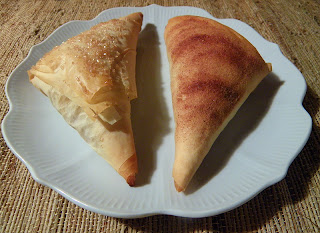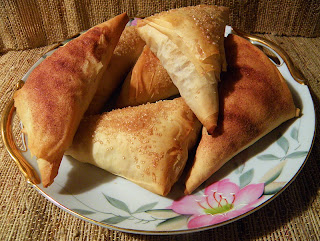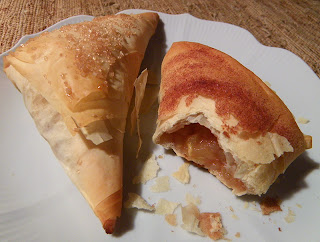 |
| Choice of Toppings |
Recipe from The Cooking Decade
A lowfat apple turnover sounds too good to be true, or at
least too unusual to be delicious. However, in The Cooking Decade, a collection of tried and true family recipes
compiled by my sister Chris, it is marked “Outstanding.” I’m not a phyllo dough
expert, in fact have only used it twice to make spanakopita, many years ago.
Though this recipe is easiest if you have some phyllo finesse, it is truly hard
to ruin. The original recipe calls for cutting the phyllo into long equal
strips and stacking them up. Easier said than done for phyllo novices with
limited counter space. So on my second try, I cut the dough crosswise, to make
shorter, wider sheets. Then I stacked two manageable-sized sheets and folded
them. This seemed an easier way to make even dough strips, with fewer torn
edges. Also, the turnovers were fewer and plumper, hardly a disadvantage.
 |
| Perfect Autumn Brunch Treat |
Also, as soon as the sheet is on the working surface, spray it with cooking spray. Then use a brush to even out the layer of spray. Make sure edges are covered with oil; they’ll tear if they get too dry. Torn, uneven edges, small holes, and other flaws might look funky while turnovers are raw, but once baked these turnover faux pas are all but invisible. Check out Magie’s Place is Cooking on youtube to watch a video that makes working with phyllo look easy. Practice makes perfect.
 |
| Ready for the Oven |
Organic phyllo is available these days, as well as
wholewheat phyllo (I haven’t tried the latter, but I’m almost confident enough
now to try it). Look for products from the Fillo Factory in the frozen foods
section of your local natural foods store.
 |
| Sealing Apples into Turnover |
makes about 10
2¼ cups peeled,
finely chopped cooking apples (about 1lb.)
1½ tsp. lemon juice
¼ cup evaporated cane juice (raw sugar)
1 tbsp. flour
½ tsp. cinnamon
1/8 tsp. nutmeg
1/8 tsp. salt
~10 sheets (½ pkg.) frozen phyllo dough, thawed
Sunflower oil spray
~2 tsp. walnut oil
~2 tbsp.coarse raw sugar or 1 tbsp. fine cinnamon sugar
In small mixing bowl, gently toss together apples and lemon
juice. In a smaller dish, stir together evaporated cane juice (sugar), flour,
cinnamon, nutmeg, and salt. Sprinkle sugar mixture over the apples, toss
together, and set aside.
Preheat oven to 400 degrees F. Spray a baking sheet or two
with oil, and even out the layer of oil with a brush.
Unwrap the phyllo dough and remove one sheet at a time.
Cover the phyllo stack with a slightly damp, wrung-out tea towel. Put one sheet
onto your working surface. Spray sheet with oil, then spread into an even layer
with brush. Be sure to coat edges with oil.
You will be cutting and folding the longer edge into
quarters: Cut sheet in half with knife, from one longer side to the other. Lift
one sheet and put it on top of the other. Fold sheets in the middle, bringing the edges
that you cut together. Spray the top with oil and brush out to edges. This will
make one turnover.
Alternatively, when you develop phyllo skills, you can make
two turnovers at once. After covering the first sheet with oil, remove another sheet
from the stack and put it directly on top of the first (don't worry if it's not perfectly aligned, if there are tears in the sheet, etc.). Spray with oil and
brush oil to edges. Now when you cut the sheet in half, you already have a
double layer. Fold each half in half parallel to the cut you made. Brush with
oil.
For each turnover, use a heaping tablespoon; about 2½ – 3
level tablespoons, of apple mixture. Don’t use any liquids that accumulate in
the bowl or the turnovers will be soggy. Scoop the apple mixture onto the dough
about 1 inch from edges. Fold one edge over to form a triangle and crimp the
edges. Fold again into second triangle and crimp edges again. Continue folding
into triangles as you would a flag. Refer to the last part of the video at Magie’s Place is Cooking
for a demo.
As you make the turnovers, put them onto the oiled baking
sheet. When all are ready to bake, brush tops with walnut oil. Sprinkle with
coarse raw sugar or fine cinnamon sugar.
 |
| Seriously Outstanding Turnovers |

No comments:
Post a Comment